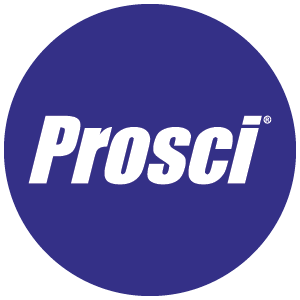Elevate Your Organizational Change Strategy With eLearning

4 Mins
Updated: August 4, 2025
Published: March 4, 2025

Transform how your organization embraces change. Success demands more than just good intentions—it requires building robust change capabilities and engaging everyone from project leaders to front-line employees in the change process. The key? Getting your entire organization aligned under a shared understanding of change management and each person's vital role in driving or adopting change.
Prosci's flexible, online, modular change management training delivers exactly what you need: a powerful way to embed change management fundamentals across your organization, reaching every leader and team member wherever they are around the globe.
What is eLearning and
Why Do Enterprises Need It?
Even with skilled change practitioners leading the way, change adoption can falter when employees don't speak the language of change management. Organizations face real challenges in spreading change management knowledge where it's needed most.
The reality is that employees encountering obstacles during change often lack the tools to overcome them. Some organizations struggle with globally dispersed teams who have limited access to change management training. Others simply can't find the right moment for comprehensive training.
Prosci eLearning cuts through these challenges with an efficient, effective solution. Our suite of four online, interactive, 45-minute modules includes:
- Introduction to Change Management
- Introduction to ADKAR®
- Introduction to Leading Change
- Thriving Through Change

Source: Prosci Introduction to Change Management eLearning Module
These modules seamlessly integrate with virtually all learning management systems, delivering instant access to your teams worldwide. Each module empowers users to apply Prosci models to real changes they're experiencing and assess their progress. Users walk away with a downloadable action plan that captures their insights and charts their path forward.
How Prosci eLearning Equips Your Organization for Change
Our eLearning modules tackle multiple organizational challenges head-on, from driving superior project outcomes to empowering sponsors and managers to lead with confidence.
Supporting project results with eLearning
Let's be clear: effective change management drives adoption and usage. Our research shows that projects with excellent change management are seven times more likely to succeed than those with poor change management. Plus, you're far more likely to deliver on time and within budget.
.png?width=500&height=163&name=7X%20more%20likely%20circles-2023%20(1).png)
While skilled change practitioners are essential, true success requires active engagement from everyone involved in the change process. How do you make this happen when time is tight, change is urgent, or your workforce is spread across the globe?
Prosci eLearning delivers quick, role-based change management knowledge that drives results. Each module connects participants directly to their specific change initiative, ensuring project teams, managers and employees gain relevant, actionable insights for their roles—all while working toward the same goal.
By elevating your change management environment and activating more resources through eLearning, you'll drive better project outcomes while building lasting change competency across your organization.
Driving change at enterprise scale with eLearning
Get ready—the pace of organizational change is accelerating. Our research shows that not only is change increasing, but these changes are increasingly complex, crossing functional boundaries and spanning entire organizations. Add in today's dispersed, often remote global workforce, and the challenge becomes clear: How will you prepare your organization to excel at change at scale?
Prosci's suite of interactive eLearning modules is your solution for reaching hundreds or thousands of people with targeted, role-specific content. Access it anytime, anywhere, on any device with an internet connection. This is how you rapidly scale change management understanding across your organization, building enterprise change management capability that delivers real results.
Engaging essential roles with eLearning

Success demands more than just individual change practitioners—it requires activating key players across your organization. Here's how Prosci eLearning equips three critical groups to drive change forward.
Use a common language for change
When change initiatives create confusion and ambiguity, progress stalls. But there's a powerful solution: create a common language for change that resonates with everyone in your organization. When you do this, change transforms from an abstract concept into something everyone can understand and actively shape.
Our ADKAR Model provides this common language, and Prosci eLearning makes it accessible to everyone. The Introduction to ADKAR eLearning module delivers this powerful framework to your entire organization—from project teams and key stakeholders to managers and front-line employees. By establishing this shared language, you're laying the foundation for smoother communication and more productive conversations about change.
Engage people managers
People managers are the key to the success or failure of a change. They're perfectly positioned to spot and address resistance while profoundly impacting each employee's change experience. Yet, our research shows they often feel unprepared for this crucial role.
Turn this challenge into an opportunity. While managers juggle packed schedules and competing priorities, Prosci eLearning modules offer a flexible path to building change leadership competency. Start with the Introduction to ADKAR module to establish a solid foundation in individual change. Then, leverage the Introduction to Leading Change module to equip them with practical frameworks for guiding their teams through transformation. This is how you transform managers into confident change leaders.
Empower employees
Engaged employees are the engine of successful change. Yet, too often, front-line employees receive minimal change management training due to time or budget constraints. The result? Frustration and resistance instead of empowered participation.
Break this cycle with Prosci eLearning. Start with the Introduction to ADKAR module, giving employees practical tools to understand and navigate their personal change journey. Follow up with the Thriving Through Change module, which transforms passive participants into active change champions. Employees emerge with concrete action plans for driving change forward.
Building change capability with eLearning
Whether you're implementing a new ERP system, restructuring your organization, or navigating an acquisition, success hinges on one factor: people adopting the change. A structured approach to the people side of change isn't just helpful, it's essential.
Forward-thinking organizations are building enterprise-wide change management capabilities that equip everyone—from employees to leaders—with the skills to drive and thrive in change. Prosci eLearning modules accelerate this journey, whether you need targeted support for specific roles or a comprehensive boost to organizational change-readiness. Build stronger change capabilities and drive better project outcomes by:
- Rapidly scaling change knowledge and establishing the ADKAR Model as your organization's language for change
- Empowering employees to take charge of their change experience through experiential learning
- Transforming people managers into confident change leaders who understand their crucial role
Equip Your Team To Play Their Part in Change
Change isn't just inevitable—it's your opportunity to get stronger. Leading organizations are revolutionizing how they implement change, and Prosci eLearning is your accelerator for building robust change capabilities.
Give your people instant access to the modules that matter most for their change roles while strengthening change management capability where it counts. The result? Better outcomes, stronger results, and change that makes your organization more resilient than ever.



